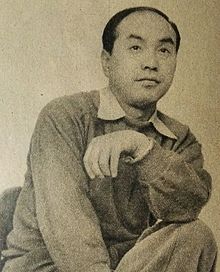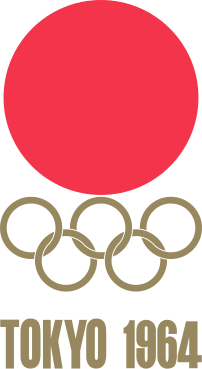Yusaku Kamekura
Yusaku Kamekura | |
|---|---|
 | |
| Born | April 6, 1915 |
| Died | May 11, 1997 |
| Occupation | Illustrator, graphic designer, graphic artist |
| Awards |
|
Yūsaku Kamekura (亀倉雄策, Kamekura Yūsaku; April 6, 1915 – May 11, 1997) was a Japanese graphic designer, the leading figure in post-World War II Japanese graphic design.[1][2] His stature in the field led to the nickname "Boss".[1]
Early life and career[edit]
Yūsaku Kamekura was born on April 6, 1915, in Yoshidamachi, Nishi-Kambara, Niigata Prefecture, Japan. He graduated from Nippon University High School in 1933.[3] He took his first paying assignment at 17, when he designed the Japanese edition of Antoine de Saint-Exupéry's Night Flight.[4]
From 1935 to 1937, Kamekura studied at the Institute of New Architecture and Industrial Arts in Tokyo.[3] The Institute was founded by Renshichiro Kawakita to bring the precepts of the Bauhaus design movement to Japan.[5] In 1938, he began working for Yōnosuke Natori laying out Nippon, a multilingual cultural magazine. Natori's training in Germany influenced Kamakura, who became fascinated with the moderns and, eventually, Bauhaus. He was a fan of Cassandre, Saint-Exupéry, and Jean Cocteau. Early on, it was recognized that Kamekura, Akira Kurosawa, and Kenzō Tange made up a trio of great Japanese visual artists of the 20th century.[6]
In 1951, Kamekura helped found the first graphic designers' group, the Japan Advertising Artists Club. He hosted the World Design Conference in 1960 but was still a trifle ashamed of the level of Japanese design. Convinced that it needed a boost and funding, Kamekura gathered the presidents of powerful corporations to sponsor a cooperative house agency: Nippon Design Center (NDC). The companies included were Asahi Beer, Toyota, Nomura Securities, Japan Railways, and Toshiba. After managing the house for two years, he left to pursue an independent career.[7]
In addition to the Bauhaus, Kamekura was influenced by the work of Cassandre and Russian constructivism.[8] John Clifford writes that Kamekura's work "blended the functionality of these modern movements with the lyrical grace of traditional Japanese design," resulting in "a boldly minimal aesthetic that used color, light, geometry, and photography."[9]
He was art director or editor for a series of magazines: Nippon (starting in 1937), Kaupapu (in 1939), and Commerce Japan (in 1949).[8]
1964 Olympics[edit]

Yūsaku Kamekura's best known work is the logo and poster series he designed for the 1964 Summer Olympics,[9] reportedly created only a few hours before the design competition deadline.[10] Kamekura eschewed the classical imagery traditionally associated with the Olympics in favor of a stark, modernist aesthetic, featuring the Olympic rings in simple gold below a red circle.[9][11]
I drew a large red circle on top of the Olympic logo. People may have considered that this large red circle represented the hinomaru, but my actual intention was to express the sun. I wanted to create a fresh and vivid image through a balance between the large red circle and the five-ring Olympic mark. I thought that it would make the hinomaru look like a modern design.[12]
The most memorable of Kamekura's Olympic posters captured a group of runners immediately after the start of a race, against a stark black background. Kamekura was the first to employ photography for Olympic posters, and this poster required split-second photography which was technically difficult to accomplish at the time.[9][11] The photograph was made by Osamu Hayasaki, a commercial photographer inexperienced in sports photography; he took 80 exposures with a telephoto lens at 1/1000 of a second, and one was selected for Olympic poster.[13] It is considered "a classic of modern poster design".[14] Kamekura went on to design posters for many other events, including the 1972 Winter Olympics and the 1970 and 1989 World Design Expos.[8]
Graphic design[edit]
Kamekura created a number of distinctive corporate logos, including NTT, Nikon, Meiji, and TDK.[14] Kamekura designed a series of logos for Nikon and the distinctive pyramid-shaped viewfinder of the Nikon F.[15]
Yūsaku Kamekura was also a prolific author. One of his most notable works was an examination of what he considered the best logo designs, 1965's Trademarks and Symbols of the World, with a preface by Paul Rand.[9] Kamekura's body of work is surveyed in his 1983 book The Works of Yusaku Kamekura.[8]
In 1989 Kamekura founded the design magazine Creation. Bilingual in Japanese and English, Creation featured profiles and 20-page portfolios of international graphic designers, illustrators, and typographers selected by Kamekura. About seven designers were featured in each issue, and each issue was 168 pages in full color with no advertising. Creation ran for exactly twenty issues until 1993.[16]
Death and legacy[edit]
Yūsaku Kamekura died on 11 May 1997 in Tokyo.[9]
References[edit]
- Saiki, Maggie Kinser. 12 Japanese Masters. New York: Graphis Inc., 2002.
Notes[edit]
- ^ a b "Graphic design - Postwar graphic design in Japan". Encyclopedia Britannica. Retrieved 2020-11-10.
- ^ Woodham, Jonathan M. (2004). "Kamekura, Yusaku (1915–97)". A dictionary of modern design. Oxford: Oxford University Press. ISBN 978-0-19-172676-7. OCLC 58893662.
- ^ a b "Yusaku Kamekura." Contemporary Designers, Gale, 1997. Gale In Context: Biography. Accessed 9 Nov. 2020.
- ^ Saiki, p. 22.
- ^ "Yusaku Kamekura". Graphis Portfolios. Retrieved 2020-11-09.
- ^ Saiki, p. 22.
- ^ Saiki, p. 23.
- ^ a b c d "Kamekura, Yusaku (1915–97)." The Thames & Hudson Dictionary of Graphic Design and Designers, Alan Livingston, and Isabella Livingston, Thames & Hudson, 3rd edition, 2012. Credo Reference. Accessed 09 Nov. 2020.
- ^ a b c d e f Clifford, John (2014). Graphic icons : visionaries who shaped modern graphic design. [San Francisco, Calif.?]: Peachpit Press. ISBN 978-0-13-315616-4. OCLC 862982083.
- ^ ""I'm going to be very predictable…" – designers on their favourite Olympic logos". Design Week. 2016-02-18. Retrieved 2020-11-11.
- ^ a b Farago, Jason (2020-07-30). "The 1964 Olympics Certified a New Japan, in Steel and on the Screen". The New York Times. ISSN 0362-4331. Retrieved 2020-11-11.
- ^ Shimizu, Satoshi (2011). "Rebuilding the Japanese Nation at the 1964 Tokyo Olympics: The Torch Relay in Okinawa and Tokyo". The Olympics in East Asia : nationalism, regionalism, and globalism on the center stage of world sports. Kelly, William W. (William Wright), Brownell, Susan. New Haven, Conn.: Council on East Asian Studies, Yale University. ISBN 978-0-578-08098-7. OCLC 775523551.
- ^ Saiki, p. 23.
- ^ a b Evamy, Michael (2012-07-31). "Total design Tokyo style". Creative Review. Retrieved 2020-11-11.
- ^ "Nikon | History | One Minute Story The secret story behind the Nikon F (1959)". www.nikon.com. Retrieved 2020-11-11.
- ^ Heller, Steven. 100 classic graphic design journals. Godfrey, Jason. London. pp. 62–3. ISBN 978-1-78067-336-3. OCLC 872715734.
